Abstract
The introduction of Cichla kelberi to the Rosana Reservoir (Paraná River basin, Brazil) was followed by a substantial loss of fish diversity in macrophyte patches, and this study investigated the hypothesis that C. kelberi was the driver of faunal disassembly via certain demographic dynamics (i.e. a pulse of juvenile fish). We analysed the variation in the structure of fish assemblages, the abundance of C. kelberi and habitat quality between 2003 and 2007, including time points that preceded and followed the introduction of the predator. A stepwise regression analysis showed that macrophyte biomass was positively correlated with assemblage attributes (richness and abundance), whereas C. kelberi density showed a strong negative correlation. Variables related to habitat quality were not included in the model, and exhibited little variation over the study years. As predicted, the density of small-bodied fish was negatively associated with the pulse of juvenile C. kelberi, and a tethering experiment revealed that predation pressure increased in the macrophyte patches when young C. kelberi were abundant. This study therefore obtained strong evidence supporting the hypotheses that C. kelberi caused the fish fauna disassembly and that the predator’s demography was the driver underlying the diversity loss.



Similar content being viewed by others
References
Agostinho, A. A., L. C. Gomes & F. M. Pelicice, 2007. Ecologia e manejo de recursos pesqueiros em reservatórios do Brasil. Eduem, Maringá.
Attayde, J. L., J. Brasil & R. A. Menescal, 2011. Impacts of introducing Nile tilapia on the fisheries of a tropical reservoir in North-eastern Brazil. Fisheries Management and Ecology 18: 437–443.
Barrela, W. & M. Petrere Jr, 2003. Fish community alterations due to pollution and damming in Tietê and Paranapanema rivers (Brazil). River Research and Applications 19: 59–76.
Britton, J. R. & M. L. Orsi, 2012. Non-native fish in aquaculture and sport fishing in Brazil: economic benefits versus risks to fish diversity in the upper River Paraná Basin. Review in Fish Biology and Fisheries 22: 555–565.
Cambray, J. A., 2003. Impact on indigenous species biodiversity caused by the globalization of alien recreational freshwater fisheries. Hydrobiologia 500: 217–230.
Casal, C. M. V., 2006. Global documentation of fish introductions: the growing crisis and recommendations for action. Biological Invasions 8: 3–11.
Casatti, L., H. F. Mendes & K. M. Ferreira, 2003. Aquatic macrophytes as feeding site for small fishes in the Rosana Reservoir, Paranapanema River, southeastern Brazil. Brazilian Journal of Biology 63(2): 213–222.
Cucherousset, J. & J. D. Olden, 2011. Ecological impacts of non-native freshwater fishes. Fisheries 36: 215–230.
Davis, M. A., M. K. Chew, R. J. Hobbs, A. E. Lugo, J. J. Ewel, G. J. Vermeij, J. H. Brown, M. L. Rosenzweig, M. R. Gardener, S. P. Carroll, K. Thompson, S. T. A. Pickett, J. C. Stromberg, P. D. Tredici, K. N. Suding, J. G. Ehrenfeld, J. P. Grime, J. Mascaro & J. C. Briggs, 2011. Don’t judge species on their origins. Nature 474: 153–154.
Espínola, L. A., C. V. Minte-Vera & H. F. Júlio Jr, 2010. Invasibility of reservoirs in the Paraná Basin, Brazil, to Cichla kelberi Kullander and Ferreira. Biological Invasions 12: 1873–1888.
Fugi, R., K. D. G. Luz-Agostinho & A. A. Agostinho, 2008. Trophic interaction between an introduced (peacock bass) and a native (dogfish) piscivorous fish in a neotropical impounded river. Hydrobiologia 607: 143–150.
Gauch Jr, H. G., 1982. Multivariate Analysis in Community Ecology. Cambridge University Press, Cambridge.
Gozlan, R. E., 2008. Introduction of non-native freshwater fish: is it all bad? Fish and Fisheries 9: 106–115.
Graça, W. J. & C. S. Pavanelli, 2007. Peixes da planície de inundação do alto rio Paraná e áreas adjacentes. Eduem, Maringá.
Havel, J. E., C. E. Lee & M. J. Vander Zanden, 2005. Do reservoirs facilitate invasions into landscapes? BioScience 55: 515–525.
Jepsen, D. B., K. O. Winemiller & D. C. Taphorn, 1997. Temporal patterns of resource partitioning among Cichla species in a Venezuelan blackwater river. Journal of Fish Biology 51: 1085–1108.
Johnson, P. T. J., J. D. Olden & M. J. Vander Zanden, 2008. Dam invaders: impoundments facilitate biological invasions into freshwaters. Frontiers in Ecology and Environment 6: 357–363.
Júlio Jr, H. F., C. Dei Tos, A. A. Agostinho & C. S. Pavanelli, 2009. A massive invasion of fish species after eliminating a natural barrier in the upper Rio Paraná basin. Neotropical Ichthyology 7: 709–718.
Kovalenko, K. E., E. D. Dibble, A. A. Agostinho & F. M. Pelicice, 2010a. Recognition of non-native peacock bass, Cichla kelberi by native prey: testing the naiveté hypothesis. Biological Invasions 12: 3071–3080.
Kovalenko, K. E., E. D. Dibble, A. A. Agostinho, G. Cantanhêde & R. Fugi, 2010b. Direct and indirect effects of an introduced piscivore, Cichla kelberi and their modification by aquatic plants. Hydrobiologia 638: 245–253.
Kullander, S. O. & E. J. G. Ferreira, 2006. A review of the South American cichlid genus Cichla, with descriptions of nine new species (Teleostei: Cichlidae). Ichthyological Exploration of Freshwaters 17: 289–398.
Kushlan, J. A., 1981. Sampling characteristics of enclosure fish traps. Transactions of the American Fisheries Society 110: 557–562.
Latini, A. O. & M. Petrere Junior, 2004. Reduction of a native fish fauna by alien species: an example from Brazilian freshwater tropical lakes. Fisheries Management and Ecology 11(2): 71–79.
Leprieur, F., O. Beauchard, S. Blanchet, T. Oberdorff & S. Brosse, 2008. Fish invasions in the world’s river systems: when natural processes are blurred by human activities. PLOS Biology 6(2): 404–410.
Leprieur, F., S. Brosse, E. Garcia-Berthou, T. Oberdorff, J. D. Olden & C. R. Townsend, 2009. Scientific uncertainty and the assessment of risks posed by non-native freshwater fishes. Fish and Fisheries 10: 88–97.
Light, T. & M. P. Marchetti, 2007. Distinguishing between invasions and habitat changes as drivers of diversity loss among California’s freshwater fishes. Conservation Biology 21(2): 434–446.
Lövei, G. L., T. M. Lewinsohn & Invasions in Megadiverse Regions Network, 2012. Megadiverse developing countries face huge risks from invasives. Trends in Ecology and Evolution 27: 2–3.
MacDougall, A. S. & R. Turkington, 2005. Are invasive species the drivers or passengers of change in degraded ecosystems? Ecology 86(1): 42–55.
Martin, C. W., M. M. Valentine & J. F. Valentine, 2010. Competitive interactions between invasive Nile tilapia and native fish: the potential for altered trophic exchange and modification of food webs. PLOS One 5(12): e14395.
Menezes, R. F., J. L. Attayde, G. Lacerot, S. Kosten, L. C. Souza, L. S. Costa, E. H. Van Nes & E. Jeppesen, 2012. Lower biodiversity of native fish but only marginally altered plankton biomass in tropical lakes hosting introduced piscivorous Cichla cf. ocellaris. Biological Invasions 14: 1353–1363.
Miranda, L. E. & K. B. Hodges, 2000. Role of aquatic vegetation coverage on hypoxia and sunfish abundance in bays of a eutrophic reservoir. Hydrobiologia 427: 51–57.
Miranda, L. E., M. Spickard, T. Dunn, K. M. Webb, J. N. Aycock & K. Hunt, 2010. Fish habitat degradation in U.S. reservoirs. Fisheries 35(4): 175–184.
Novaes, J. L. C., E. P. Caramaschi & K. O. Winemiller, 2004. Feeding of Cichla monoculus Spix, 1829 (Teleostei: Cichlidae) during and after reservoir formation in the Tocantins river, Central Brazil. Acta Limnologica Brasiliensis 16(1): 41–49.
Owen, P., 1993. Knots. Running Press, Pennsylvania.
Paolucci, E. M., H. J. MacIsaac & A. Ricciard, 2013. Origin matters: alien consumers inflict greater damage on prey populations than do native consumers. Diversity and Distributions 19(8): 988–995.
Pelicice, F. M. & A. A. Agostinho, 2006. Feeding ecology of fishes associated with Egeria spp. patches in a tropical reservoir, Brazil. Ecology of Freshwater Fish 15(1): 10–19.
Pelicice, F. M. & A. A. Agostinho, 2009. Fish fauna destruction after the introduction of non-native predator (Cichla kelberi) in a neotropical reservoir. Biological Invasions 11: 1789–1801.
Pelicice, F. M., A. A. Agostinho & S. M. Thomaz, 2005. Fish assemblages associated with Egeria in a tropical reservoir: investigating the effects of plant biomass and diel period. Acta Oecologica 27: 9–16.
Pelicice, F. M., S. M. Thomaz & A. A. Agostinho, 2008. Simple relationships to predict attributes of fish assemblages in patches of submerged macrophytes. Neotropical Ichthyology 6: 543–550.
Pelicice, F. M., J. R. S. Vitule, D. P. Lima Junior, M. L. Orsi & A. A. Agostinho, 2014. A serious new threat to Brazilian freshwater ecosystems: the naturalization of nonnative fish by decree. Conservation Letters 7: 55–60.
Pinto-Coelho, R. M., J. F. Bezerra-Neto, F. Miranda, T. G. Mota, R. Resck, A. M. Santos, P. M. Maia-Barbosa, N. A. S. T. Mello, M. M. Marques, M. O. Campos & F. A. R. Barbosa, 2008. The inverted trophic cascade in tropical plankton communities: impacts of exotic fish in the Middle Rio Doce lake district, Minas Gerais, Brazil. Brazilian Journal of Biology 68: 1025–1037.
Rahel, F. J., 2007. Biogeographic barriers, connectivity and homogenization of freshwater faunas: it’s a small world after all. Freshwater Biology 52: 696–710.
Ruesink, J. L., 2005. Global analysis of factors affecting the outcome of freshwater fish introductions. Conservation Biology 19(6): 1883–1893.
Sanches, F. H. C., C. A. Miyai, T. M. Costa, R. A. Christofoletti, G. L. Volpato & R. E. Barreto, 2012. Aggressiveness overcomes body-size effects in fights staged between invasive and native fish species with overlapping niches. PLOS One 7(1): e29746.
Schlaepfer, M. A., D. F. Sax & J. D. Olden, 2011. The potential conservation value of non-native species. Conservation Biology 25(3): 428–437.
Simberloff, D. & B. Von Holle, 1999. Positive interactions of nonindigenous species: invasional meltdown? Biological Invasions 1: 21–32.
Simberloff, D., J. L. Martin, P. Genovesi, V. Maris, D. A. Wardle, J. Aronson, F. Courchamp, B. Galil, E. García-Berthou, M. Pascal, P. Pyšek, R. Sousa, E. Tabacchi & M. Vilà, 2013. Impacts of biological invasions: what’s what and the way forward. Trends in Ecology and Evolution 28: 58–66.
Souza, J. E., E. M. Fragoso-Moura, N. Fenerich-Verani, O. Rocha & J. R. Verani, 2008. Population structure and reproductive biology of Cichla kelberi (Perciformes, Cichlidae) in Lobo Reservoir. Brazil. Neotropical Ichthyology 6(2): 201–210.
Statsoft, 2005. Statistica (data analysis software system), version 7.1. StatSoft Inc, Tulsa.
Thomaz, S. M., A. A. Agostinho, L. C. Gomes, M. J. Silveira, M. Rejmánek, C. E. Aslan & E. Chow, 2012. Using space-for-time substitution and time sequence approaches in invasion ecology. Freshwater Biology 57: 2401–2410.
van Nes, E. H., M. Scheffer, M. S. van den Berg & H. Coops, 2002. Aquatic macrophytes: restore, eradicate or is there a compromise? Aquatic Botany 72: 387–403.
Villares Junior, G. A. & L. A. Gomiero, 2010. Feeding dynamics of Cichla kelberi Kullander & Ferreira, 2006 introduced into an artificial lake in southeastern Brazil. Neotropical Ichthyology 8(4): 819–824.
Vitule, J. R. S., C. A. Freire & D. Simberloff, 2009. Introduction of non-native freshwater fish can certainly be bad. Fish and Fisheries 10: 98–108.
Vitule, J. R. S., C. A. Freire, D. P. Vazquez, M. A. Nuñez & D. Simberloff, 2012a. Revisiting the potential conservation value of non-native species. Conservation Biology 26(6): 1153–1155.
Vitule, J. R. S., F. Skóra & V. Abilhoa, 2012b. Homogenization of freshwater fish faunas after the elimination of a natural barrier by a dam in neotropics. Diversity and Distributions 18: 111–120.
Zaret, T. M. & R. T. Paine, 1973. Species introduction in a tropical lake. Science 182: 449–455.
Acknowledgements
We thank Universidade Estadual de Maringá, PEA and Nupélia for creating ideal conditions for this research. We also thank the staff who helped with the field sampling and laboratory analyses. CAPES provided a scholarship for F.M.P. during his doctoral work, and CNPq provided a research grant for A.A.A and F.M.P. Finally, we thank the Editor and two anonymous reviewers for their valuable comments.
Author information
Authors and Affiliations
Corresponding author
Additional information
Guest editors: Sidinei M. Thomaz, Katya E. Kovalenko, John E. Havel & Lee B. Kats / Aquatic Invasive Species
Rights and permissions
About this article
Cite this article
Pelicice, F.M., Latini, J.D. & Agostinho, A.A. Fish fauna disassembly after the introduction of a voracious predator: main drivers and the role of the invader’s demography. Hydrobiologia 746, 271–283 (2015). https://doi.org/10.1007/s10750-014-1911-8
Received:
Revised:
Accepted:
Published:
Issue Date:
DOI: https://doi.org/10.1007/s10750-014-1911-8




